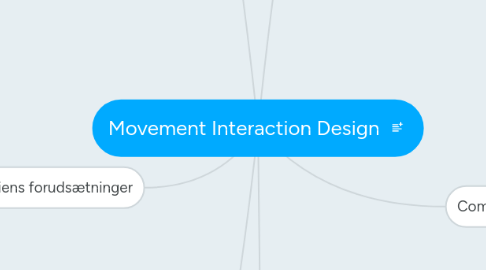
1. Interaktion
1.1. Physical computing
1.2. Augmented reality
1.3. Virtual reality
1.4. Exergaming
1.5. Antropromorphization
1.6. Tangible interaktion
1.7. Embodied interaction
1.7.1. Link til embodiment
1.7.2. Link til embodied cognition
2. Making
2.1. Mash-up
2.2. Tinkering
2.2.1. Pragmatic
2.2.2. Intrinsic
2.2.3. Epistemic
2.3. Prototyping
2.4. Wizard of Oz
2.5. Tangible artifacts
2.6. Seymour Papert / constructivism
2.6.1. Risk
2.6.2. Thinking through doing
2.6.3. VISIBILITY
2.6.4. THICK PRACTICE
2.6.5. Performance
2.6.6. Epistemic pluralism
2.7. Iterative approach
3. Teknologiens forudsætninger
3.1. Programmeringsparadigmer
3.1.1. Sekventielt
3.1.2. Ekspertsystemer
3.1.3. Fuzzy logic
3.1.4. Kunstig intelligens
3.1.5. Deklarative / logiske
3.2. Datalagring
3.2.1. Markup / XML
3.2.2. Relationelle databaser
3.3. Design tools
3.3.1. E/R diagrammer
3.3.2. Rutediagrammer
3.3.3. Context/niveau 0 diagrammer
3.3.4. Tilstandsdiagrammer
3.4. History
3.4.1. Teknologiens forudsætninger
3.4.1.1. Digital/analogt
3.4.1.2. Sensorer
3.4.1.3. Filtre
3.4.1.4. Aktuatorer
3.4.1.5. Morfologien
3.4.1.5.1. Robotter
3.4.1.5.2. Kropslig intelligens
3.4.1.5.3. Decentrale beslutninger
3.4.2. WEB1.0
3.4.3. Web2.0
3.4.4. WEB3.0 - semantic web
3.4.5. Systemtyper
3.4.5.1. Client-server
3.4.5.2. Stand-alone
3.4.5.3. (en tredje.. hvad hulen hed den nu)
4. Platforms
4.1. Prototyping
4.1.1. Scratch
4.1.2. App-inventor
4.1.3. IFTTT
4.1.4. POP - app
4.2. Tangible artifacts
4.2.1. 3D print
4.2.2. Play doh
4.2.3. Lego
4.2.4. Pap, piberensere oa
4.3. mash-ups
4.3.1. Mindstorms
4.3.2. Makey Makey
4.3.3. Arduino / Grove
4.3.4. Littlebits
4.4. discovering
4.4.1. paper based mock ups
4.4.2. PowerPoint
4.5. Choice of platform
4.5.1. Ease of Use
4.5.2. Duration of use (once / longer time)
4.5.3. question to be explored
4.5.4. Intended use
4.5.5. Test type
4.5.5.1. Styret / faciliteret
4.5.5.2. Observeret
4.5.5.3. Støttet
5. Communication
5.1. Shannon-weaver
5.1.1. Feedback
5.1.2. Sender
5.1.3. Receiver
5.1.4. Noise
5.2. Formaliserende medier
5.2.1. Databaser
5.2.2. Tekst
5.2.3. Noder
5.2.4. Algoritmer
5.3. DIKW
5.3.1. Information
5.3.2. Data
5.3.3. Knowledge
5.3.4. Wisdom
5.4. Komplekse kommunikationsmodeller
6. Motivation
6.1. Intrinsic
6.1.1. Social factors
6.1.1.1. Sex
6.1.1.2. Fun
6.1.1.3. Status
6.1.2. Goal oriented
6.1.2.1. Skill
6.1.2.1.1. Body awareness
6.1.2.1.2. Kinesthetic empathic Interaction
6.2. Extrinsic
6.2.1. Nudging
6.2.2. Force
6.2.3. Play / fun
6.2.3.1. Gamification
6.2.3.1.1. Well-played / poorly played game
6.2.3.1.2. The broken game
6.2.3.1.3. Performancebased
6.2.3.1.4. Achivements- based
6.2.3.1.5. Social sharing
6.2.3.1.6. Self-effacing games
6.2.3.1.7. Impossible games
6.2.3.2. Social interaction
